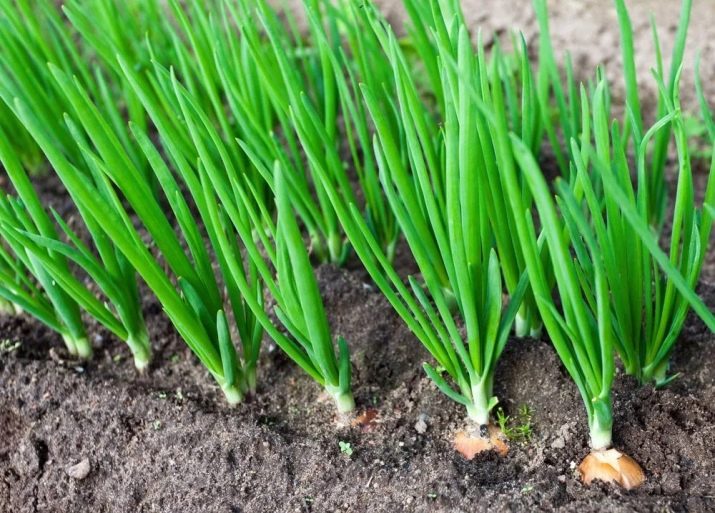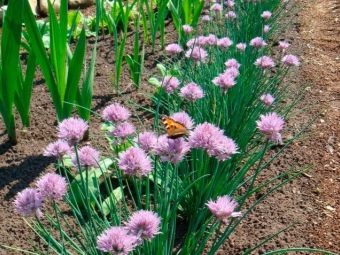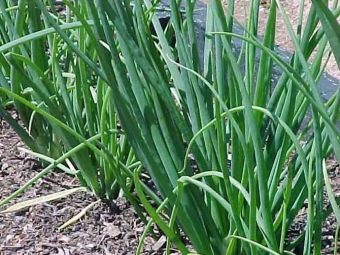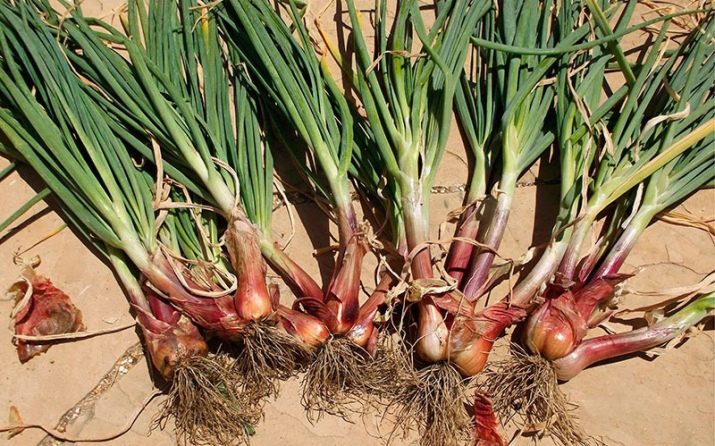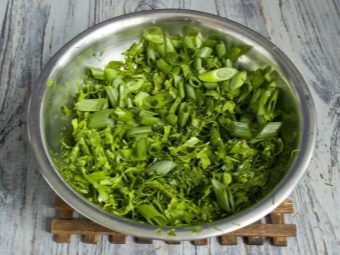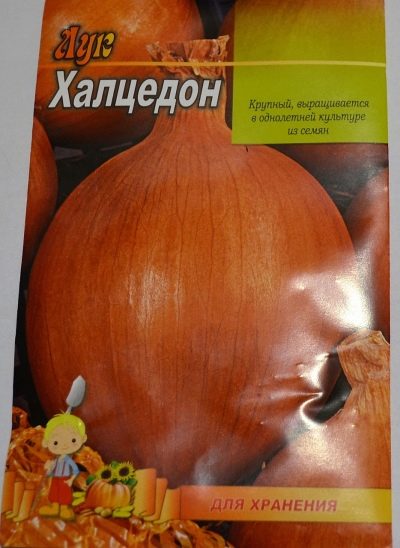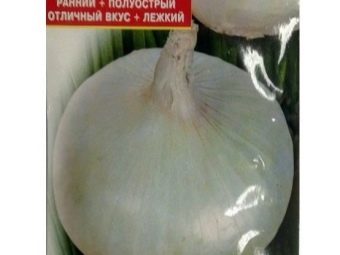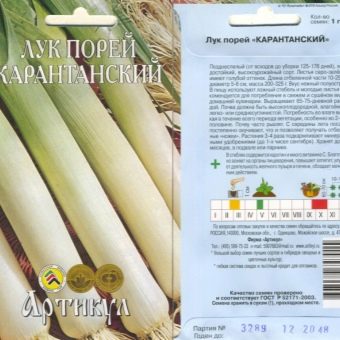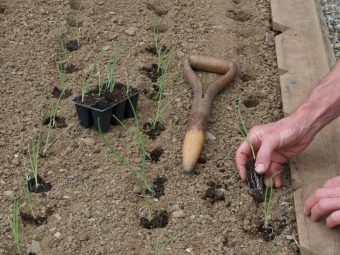Types and varieties of onions
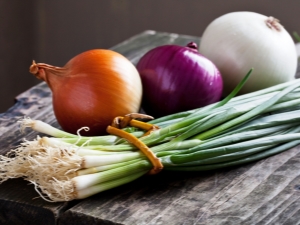
Onion is one of the oldest cultures. At first he met in the wild, but gradually more and more of his cultivated varieties appeared.Today, onions can be found in almost every summer cottage.
Characteristic
Onion is one of the most ancient herbaceous plants of the subfamily of Onions, a genus of Onions. It is found in both wild and cultivated form. It is a perennial or biennial plant.
Consists of a bulb and a green stalk. From the point of view of botany, the bulb is at the same time a bud, leaves and part of the stem. The stem is also called the pipe, its height can reach about 1 m (depending on the variety). The plant has a characteristic onion, sometimes garlic, aroma, which is associated with a high content of essential oils in the composition.
Onions can be divided into edible and decorative, with some varieties may be attributed directly to both groups. The history of onion cultivation totals about 5 thousand years. It is believed that the very first onion was cultivated.
Onions are rich in biologically active substances. Among them are sugar, nitrogenous substances, flavonoids, acids of organic origin, phytoncides. Vitamin-mineral composition is represented by vitamins A, B, C, PP, sulfur, phosphorus, calcium. Onion has a pronounced immuno-strengthening, tonic, antibacterial effect. It is useful for the digestive system, cardiovascular system, rescues from anemia, colds and beriberi.
Main varieties
There are many varieties of onions. The plant can be attributed to one group or another, depending on which characteristic underlies the classification. The largest and, perhaps, the first is the classification of onions into wild and domesticated. At the same time, the wild is also usually edible, but the number of its species gradually decreases, which is associated with human economic activity. In this regard, some species of wild onions are listed in the Red Book, and some are considered extinct.
Cultivated onion can also be divided into edible and decorative (although more often one species combines both characteristics), a perennial and a two-year.
If we talk about taste, then onions can be spicy, semi-sweet and sweet. Interestingly, all species contain in the composition of sugar, while in bitter species their content is higher than in sweet ones (the first ones contain about 11% of sugars, the second - 5%). Bitterness is due to the presence of essential oils. In the bitter varieties of them contains the most that also causes the characteristic smell and "tearing" onions.
Depending on the time of planting, there is a bow that is planted in spring and a winter look. Winter onions can be planted from late summer to late September, it should be 25-27 days before the first steady frosts. It should take root and get a little stronger until the temperature drops significantly.
For growing under the snow you need to take frost-resistant varieties. Moreover, this method of cultivation is suitable only for those regions where snow falls in the winter at least 15-20 cm thick. If the snow cover is thinner, then the bulb will die at a temperature of 10-12 degrees.
Most types of winter onions do not increase the turnip badly, so they are cultivated for the sake of green. It usually appears after the snow melts, already in early to mid-April.
One of the most common is onions. It forms an onion resembling a turnip - an elongated circle with a “bottom”. It is a two-year-old plant - in the first season, the crop becomes a plant. These are small onions that are planted for the next season to form onions.
Seeds (chernushka) can be bought or collected in boxes, ripening on an adult plant (for this you do not need to tear off the arrows of the onion).
"Turnip" is also divided into several varieties - yellow, white and red. Yellow onions, perhaps the most famous variety of culture. It has golden husk and white flesh. Due to the large amount of essential oils, yellow turnips emit a strong onion flavor. It is considered a neutral species, because the level of sweetness and bitterness in it is balanced.Differs in universality of application, is suitable for the majority of dishes. In the process of heat treatment loses most of the flavor and bitterness, becoming more tender. Due to the high keeping quality and trouble-free transportation is widespread.
White onion has a white husk and has a less sharp and delicate flavor. That he is the basis of the famous French soup. Among its shortcomings - a small shelf life, only 3-4 months after harvest.
Red onion has a purple-burgundy color of the husk and white, with purple streaks, flesh. It is characterized by a piquant taste, therefore it is more often consumed fresh, it is also called “salad”.
It is a mistaken opinion that red is necessarily a sweet onion. There are both semi-sweet and bitter varieties of it. The most famous red onion with a sweet taste is Yalta. It grows in a certain territory of the Crimea and is used as an apple, its taste is so sweet and juicy.
A kind of "turnip" is shallot, which is a multi-nest species. Other names - "bush" or "family." It got its name due to the fact that 3-15 onion matures in one nest. Outwardly, they are similar to onion, but have a more elongated shape and less weight.
Green feathers have a weak wax coating and a more delicate flavor. The bulbs are also distinguished by their unsharp taste and lack of onion smell. He is very appreciated by gourmets for a gentle, but at the same time savory taste.
However, it is not recommended to fry it - the shallot becomes bitter. In addition, it has a “non-capricious” character - it does not fear frost, is unpretentious in agricultural technology, and is immune to most diseases typical of culture.
The above varieties of onions are usually grown for harvest - the bulbs. Although the young green shoots are actively eaten. The next species is grown exclusively on greens, because it does not increase the onion. It is about the onion-batun. This perennial crop (sometimes grown as an annual) is distinguished by high yields (you can harvest 3–4 times per summer) and cold resistance.
Greenery appears in early spring and retains its taste until the beginning of autumn frosts. The feather is rather large, hollow inside, therefore this species is also called fist (shoots resemble pipes). Suitable for salads, first and second courses, is widely used in Asian cuisine, in dishes that are cooked in a wok pan. It goes well with fish and seafood.
Taste may vary by species. So, Korean and Japanese varieties are characterized by a more delicate and mild flavor than the Chinese. Despite the relatively simple agricultural practices, the batun is demanding of soil fertility.
With the batun similar stone, or Mongolian bow. He also produces dark green hollow shoots, but their height and wall thickness is less, and the taste is softer, spicy. Mongolian onions are found in both cultivated and wild.
Another type of onion on the greens - shnitt. Although it can be attributed to the decorative - so beautiful plant during flowering. Other names Schnitt - "Rezun" ("chisel"), "tribulk", "skoroda".
Greens of such onions low (up to 30 cm), tender, have a bright green color. Feathers are thin, they can be collected several times per season. The flowering period is at the end of May and the beginning of June, the plant begins to flower from the second year of life. At the end of summer, seed boxes are formed instead of flowers.
One of the advantages of Schnitt is its frost resistance. Gentle shoots withstand a slight negative temperature, and for adults are not afraid of frost down to -8 degrees. The plant does not form bulbs, but has branched roots. It is usually bred by seeds, with the seedlings looping very weak, they need careful protection from weeds.
Another favorite of gardeners - a two-year leek (or "pearl").It is also resistant to frost, has no difficulty with agricultural technology, adapts to most climatic conditions. In general, similar to onions, but does not form an onion head.
Harvest are the stem (false bulb) and bluish-green shoots. The latter are large and wide shoots, similar to garlic, whose height can reach 1 m. Green feathers are tasty only in the late spring-early summer, then they become coarse. In the fall, the whitish stem is usually kept in order to increase its size (to make it longer) the plant is highly spud.
Leek is characterized by a delicate flavor and spicy onion flavor. Good for salads, soups, as a filling for pies. It is harmoniously combined with cheeses, there are even dishes that are leek stuffed with cheese filling.
There is a wild species of leek - Kavar. Cooks and gourmets appreciate it for a more spicy taste and aroma.
Multi-tiered
Tiered bow has a remarkable "appearance." At the beginning of his growing season, he is similar to a batun. However, later on his arrow bulbs formed - fairly large aerial bulbs. They are formed at different heights (which explains the name "multi-tiered") by about the middle of summer, starting from the second year of the plant's life. Since the bulbs are usually formed in two tiers, it is also called bunk.
As they mature, they are increasingly leaning towards the ground under their own weight. In contact with the soil, they take root - this is how a new green bush is formed. Because of this feature, this view is also called “walking.”
Greens of a multi-tiered onion juicy, with a slightly bitter taste and a strong onion flavor. It is universal in application, but it is especially well combined with meat dishes. Breeding can be carried out both with the help of brooches, and traditional planting of bulbs in the ground. The species is characterized by unpretentiousness in care, resistance to cold and drought, the presence of immunity to the most common diseases for culture.
Branched
The place of growth of fragrant (another name for branched) onions are the mountains of Central Asia, the southern territories of Altai, Eastern and Western Siberia. It is common in Kyrgyzstan and Mongolia, where it is called "Dzhusay" and put into most of the national dishes, is also used in Japanese cuisine (included in the "miso soup"), harmonious in tandem with fish dishes.
The plant does not form a bulb suitable for consumption, usually only green shoots are used as food. They have a slight smell and taste of garlic. Outwardly, they also look like a garlic socket - flat thin shoots of small height. They can be cut several times over the summer, but this can only be done from the second year of the plant’s life. Instead of a bulb, a long stem is formed, the diameter of which is 2-3 cm.
The name "fragrant" look acquired thanks to the delicate and pronounced aroma of inflorescences. In general, a branchy onion is unpretentious in care, tolerates drought well, but shows good yield only with a sufficient level of soil moisture.
Slizun
Onion-slizun distinguishes first of all a light, but rather pronounced garlic note in taste. Green shoots are used in food. In appearance, they are flat fleshy tape-like shoots with rounded edges. Slizun, and also it is called drooping and ferruginous, not only suitable for use, but also will decorate the summer cottage. During flowering, large inflorescences of white or pink color are formed (blooms in the second year after planting).
The name of the species was due to the protruding thick juice (resembling mucus), which appears when you cut off the green feather. The bow was nicknamed because its flower stalks tend to the ground, straightening only during the period of seed ripening.
Differs in impressive frost resistance - maintains decrease in temperature to -40 degrees. In growth goes even at zero temperature.Refers to perennial species of onions, demonstrates yields up to 5 years. The breeding method is growing season; it is recommended to plant onions in spring or early autumn.
Speaking about the varieties of onions, it should be noted that it also includes garlic, wild garlic (wild onion with garlic flavor and aroma), as well as diverse varieties of wild and decorative onions.
Popular varieties
Among the popular varieties of onion sets can be distinguished "Chalcedony", respected by gardeners for the possibility of cultivation in the open field (for the southern regions). Suitable for growing bulbs and greens, demonstrates quite a good yield (average 4 kg per 1 m2). The term of maturation is 95-110 days, characterized by resistance to rot and peronospora. Medium sized bulbs weighing about 100 g with a pleasant mild flavor and a slight bitterness.
The early variety "Stuttgarter Riesen" is also popular. This is due to a short period of aging, aversion to bolting, resistance to powdery mildew, decay, good yield. The bulbs are quite large, weighing 250-300 g, taste is neutral with a strong aroma.
A similar early maturing variety is “Snowball”, which, however, has a more delicate flavor with a little speck. It is considered a salad variety.
If we talk about varieties with good keeping quality, then we should highlight “Centurion”, “Orion”, “Bamberger” (demonstrates high resistance to rot), “Sturon”, considered earlier by “Stuttgarter Risen”. The names “Sturon” and “Centurion” usually indicate the designation “F1”, which means that they belong to heterotic hybrids.
Description of hybrids usually includes information about good yields, unpretentiousness in the care, as well as varieties demonstrate the ability for long-term storage. Such is the onion "Golden Semko F1", which is more profitable to grow seedlings, and in the southern regions or under the film - seeds as an annual.
Another variety suitable for storage throughout the winter is the middle-end Shetana. It is a universal "turnip" with a period of maturation of 70-80 days when disembarking by sevke. The variety belongs to high-yielding, however, these figures depend on the method of planting (sevka gives bulbs 2 times larger) and climatic features. Suitable for landing in the winter.
Salad varieties are mostly represented by red onions, which have a pleasant sweetish taste and more tender greens than other types of "turnip". In this category, the Dutch varieties “Bombay” and “Brunswick” should be noted. The first refers to the mid-season, the second to the early varieties. Both species have a delicate semi-sharp taste and demonstrate good keeping quality.
Another variety of red onion is mid-season "Carmen." From planting (can be diluted with seeds or planting) to harvest takes an average of 120-130 days. Harvest - bulbs with purple-red husks and semi-sharp flesh. The advantage is good maturity and keeping quality.
Variety "Setton" does not apply exclusively to the salad, but many of these yellow onions are grown just for fresh consumption. This is due to its sweetish taste with a slight, sharp, piquant touch. At the same time, thanks to the dense skin and the upper petals, Setton is well preserved and remains juicy for a long time.
Elite varieties include the Red Onion Red Bar, which is characterized by an early ripening period (90-95 days), high yield and keeping quality. The average weight of the bulbs is 18-24 g, it is recommended to plant onion seedlings for a larger crop.
Incredibly popular sweet salad onion "Yalta". Authentic taste can be obtained only when growing a variety in a certain corner of the Crimea, however, in general, Yalta onions can be cultivated in the southern regions and central Russia. Taste and sweetness depend on the region and features of care.
Among the varieties of white onions, it should be noted "Albenka" (early ripening variety, the bulbs of which differ in a piquant combination of sharpness and sweetness), "White Globe" (early variety, gardeners note its friendly germination, stable yield, disease resistance). Hybrid white onion is a "Sterling" with a ripening period of 110-120 days. It has a unique, dissimilar taste. It can be attributed to the sweet varieties.
If you like a larger “turnip”, then you should pay attention to the varieties “Globo” (mid-seasoned lettuce, weight - 600-800 g), “Exhibichen” (sweet, late-ripening variety with the same mass of onions).
Positive reviews of gardeners also receive shallot varieties with good keeping quality "Atlas" and "Bessonovsky local." The first refers to the hybrid, early, bulbs are small with beautiful bronze husks. "Bessonovsky" is also characterized by early ripening, forms larger golden bulbs.
Among the best varieties of chives is usually celebrated "Honey". First greens can be cut 35 days after emergence of shoots. Feathers have a beautiful shade, have a semi-sharp taste.
Winter hardiness is characterized by mid-ripened chunks "Albion" and "Spring". The first has a rather pungent taste, the second belongs to mid-acute. Winter resistance is different and onion "Olin", which is suitable for planting in the winter. If, however, plant it as a biennial in spring, the harvest is characterized by good keeping quality.
In the middle lane, one can cultivate such varieties of leeks as the late-ripening Karantansky, the frost-resistant late ripening Winter Giant, the two-year-old Elephant's Trunk, and the lettuce White Bee Lisbon.
In the middle of the batun, the early "April" deserves attention. If winter onions are necessary, then the semi-sharp “Russian Winter” is usually recommended, which can be grown as an annual and as a perennial variety.
Choosing a particular variety of onions, you should focus on the climate zone where it will be cultivated. Each region differs in the amount of heat and light received, the length of the summer, so the southern varieties do not have time to ripen in the areas of the Urals and Siberia. And those that are designed for forcing in the Far East, for example, do not tolerate elevated temperatures and droughts, which is typical of the southern regions of the Volga region.
For Siberia
Given the harsh climate of Siberia, varieties for cultivation here need to choose the most resistant. They must have time to ripen in a short summer and be unpretentious to the quality of the soil, in particular, to produce on podzolic soils. In addition, for most gardeners are important characteristics such as disease resistance, high yields and good keeping quality.
These criteria correspond to "Stuttgarter Risen", "Shturon", "Centurion", "Orion". “The Red Baron”, referring to the salad, is ideal for preparing marinades, characterized by a slightly shorter shelf life. Early maturing Serpentine and Firefly with an early aging period are good for this region.
The varieties Siberia, Black Prince, Siberian Annual, and hybrid varieties of Daytona and Candy show consistently good yields.
Because of the short summer, it is better to grow onions with a sevka, and not with seeds. On the feather you can cultivate the plant in a greenhouse. If its equipment allows, it can be done all year round. Sevok better to get a medium size or small. Large onions are more prone to marksmanship.
Sevka is planted in the open ground at the end of May, but it is better to focus not on calendar dates, but on air and soil temperature. The temperature of the latter should be at least 8-10 degrees.
Growing winter onions in Siberia is possible, but requires certain measures of protection against the first frost.For this, the onion planted in the first half of October is deepened and mulched, and covered with coniferous paws for the winter. Of course, you should choose a frost-resistant variety for this purpose.
Given the resistance of the leek to cold, it can also be grown in Siberia by seedlings in open ground, as well as in the greenhouse.
For the middle band
This region is considered optimal for growing most varieties and varieties of onions. However, it should be borne in mind that in the early spring and at the end of the summer short-term frosts are possible, and in the middle of the summer rather dry periods are issued. In this regard, it is better to choose cold-resistant and drought-resistant varieties. Perennials must be frost resistant.
For the middle band, the best varieties of family onions are "Grasshopper", "Masha", "Golden". Attention deserved relatively recently by domestic breeders variety "Ellan" deserves. It belongs to frost-resistant early ripe, shows a good yield, but does not have a long storage period. It is better to use it as a salad vegetable, especially since “Ellan” has a pleasant sweet, with a small taste of ostryk.
But the Japanese shallot “Senshui Yellow” is characterized not only by early ripening and high taste characteristics, cold resistance and immunity to most diseases, but also the ability to be stored for a long time (up to 6-7 months).
For the Urals
Ural is considered to be a region of risky farming, so for cultivation here you should choose varieties with a short and medium aging period, cold-resistant. Gardeners prefer to breed culture sevke. If the seeds are used, the plant usually enters the open ground as seedlings. In this case, the onions have time to ripen for a short summer and give a good harvest, which can be stored all winter.
Because of the short summer, it is necessary to choose early and mid-season varieties of onions. Despite the fact that conditions in the Urals are milder than in Siberia, it is better to choose “Siberian” varieties for cultivation. They demonstrate better germination and will be able to better adapt to the climate than those intended for breeding in the central regions and the middle belt.
One of the oldest varieties for this region is Arzamas. Designed for two-year cultivation through sevok. The ripening time is average - from 100 to 110 days. Harvest - a dark yellow turnip with a snow-white flesh weighing 50-80 g. It is well kept all winter.
The previously mentioned “Bessonovsky local” with a ripening period of 65-80 days and a mass of “turnip” of 35-55 g are also well grown in the Urals. hybrid "Hercules".
Winter onions in the Urals should be planted from early September to mid-October, choosing the appropriate varieties. These include "Shakespeare", "Danilovsky", "Radar", as well as a hybrid "Kip Well".
How to choose?
Onions should be chosen taking into account the climatic conditions of its growth. It is necessary to take into account the features of your site - the state of the soil, the proximity of underground soils, the location of the site and onion beds.
If the yield is a priority, then yellow onions and shallots should be preferred, and if you cultivate them for salads and fresh consumption, it is better to choose red and white onions. They have a softer and more versatile taste.
If it is not possible to keep planting all winter, then it is better to give preference to the cultivation technology of annual onions. For these purposes, small-starter early maturing varieties are best, as well as hybrids with a small nest and a short growing season (Globus, Lugansky, Stuttgarter Risen).
If we talk about winter varieties, then “Shakespeare”, “Senshui”, “Radar” deserve attention. For winter planting, it is better to choose the sevines of the smallest fraction with an onion diameter of 8-14 mm.
It is necessary to determine the purpose of growing onions - whether the crop will be sowing or “full-fledged” bulbs for human consumption. In the first case, seeds should be sown, which by the end of the first season will turn into small onions. They are removed for winter storage, and in spring they are planted in the ground in order to gather onions in the fall for food consumption and storage. In other words, the plant has a 2-year growing season.
Growing onions through chernushka, you can get a quality variety and a large crop. Planting seeds ensures that they will be properly processed (provided, of course, that the gardener has carried out the necessary preparatory measures). This, in turn, provides a higher plant resistance to disease, better germination.
For risky farming regions, it is recommended to plant chernushka in early spring at home or in a greenhouse, and as the soil reaches suitable temperatures, transfer it to open ground. In the southern regions it is possible to grow onions through chernushka as an annual.
Onions on a turnip can be used to get a green pen. However, it will be possible to do this only at the beginning of summer, while the shoots are tender. As the bulb ripens, the feathers become rough and bitter. If the task is to get greens all summer, then it is better to choose perennials Shnitta, batun, slizuna, fragrant onions.
If you need an unpretentious, frost-tolerant type of onion, then this is a multi-tiered one. It can not be transplanted until 10 years, which does not affect its productivity. Among the popular varieties - "Odessa", "Gribovsky 38".
Another cool look - slizun. However, it requires fertile soils with a neutral ph. If this is about your site, choose "Leader", "Green", "Charm".
Unpretentious differs fragrant onions, especially its varieties such as "Stargazer", "Fragrant", "Savory." However, it is not suitable for dry areas (or it will be necessary to water it often), since the lack of moisture greatly affects its yield and taste of feathers.
If it is necessary to get early greens, then a batun onion will do. In addition, you can grow seedlings for planting in the spring in the ground or sow winter varieties in the fall. The latter will delight the greens before anyone else. Then there will be feathers grown onion seedlings. After the other (however, about 2 weeks earlier than other species in the open field) a batun will appear.
By the way, the latter also requires fertile soil. He does not tolerate an increase in the acidity of the earth, its waterlogging.
On the various varieties of onion, see the following video.

